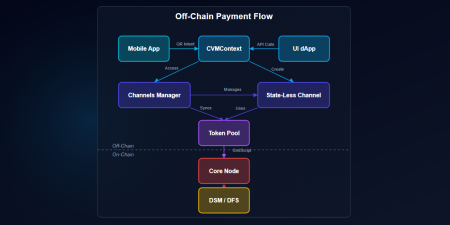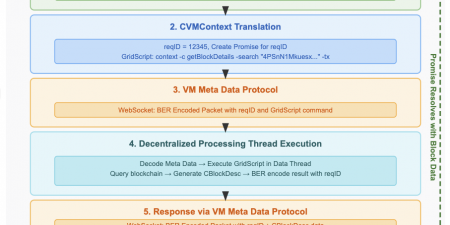Introduction
Overview of GRIDNET OS
GRIDNET OS represents a cutting-edge, decentralized state machine-based operating system, designed to redefine how humanity interacts with decentralized systems. It allows for the creation and management of services and applications of various types, including decentralized graphical, windowed applications akin to those in ‘centralized’ operating systems like Microsoft Windows, Linux, or Mac OS X. At its core, GRIDNET OS comes with the capability of executing and managing transactions securely and efficiently across a distributed network. This OS caters to a wide range of applications, making it particularly appealing to entities that require robust, transparent, and tamper-proof systems.
In the nomenclature of GRIDNET OS, a transaction is any ordered and authenticated sequence of instructions broadcasted across the network for processing. The purpose of an instruction is to affect the state of GRIDNET OS’ decentralized state machine. This definition emphasizes that transactions in GRIDNET OS may extend beyond the traditional concept of a value transfer, commonly associated with the cryptocurrency realm.
To fully grasp the capabilities of GRIDNET OS, it is essential to understand the different types of transactions it supports:
- Transactions as Value Transfers (Case 1): This type resembles traditional transactions in blockchain systems, where the primary objective is the transfer of value or assets between parties.
- Transactions as Code Bundles (Case 2): In this case, transactions are complex sets of instructions or code, broadcasted across the network to perform various operations within the GRIDNET OS ecosystem. These could range from simple data updates to the execution of sophisticated decentralized applications.
- Off-The-Chain Transactions (Case 3): ultra fast transactions with deferred processing at the GRIDNET OS’ decentralized state machine. The topic is outside the scope of this article.
GRIDNET OS allows for both types of transactions, with the important note that Case 1 is always a subset of Case 2. In the end Case 3 always ends up as part of Case 2 as well. This flexibility opens up a plethora of possibilities for how transactions can be structured and utilized within the network.
This article focuses on the RESTful API of GRIDNET OS, specifically two of its functions – sendTX and processCode. The rationale is to shed as much light as possible before the upcoming integrations with CEXs – so to give external entities a healthy amount of understanding before proceeding with integrations of GRIDNET OS into their eco-systems. The sendTX function is primarily concerned with transactions as defined in Case 1, facilitating a priori defined value transfers. It’s designed for simplicity and efficiency, allowing for quick and secure asset transfers within the GRIDNET OS ecosystem. This function is integral for users and applications that require straightforward, reliable value exchange capabilities.

GRIDNET OS Transactions – secure, fast and truly decentralized.
On the other hand, the processCode function caters to Case 2, enabling the broadcasting of complex code bundles across the network. This function is crucial for leveraging the full potential of GRIDNET OS, as it allows for the execution of diverse and sophisticated operations. From deploying smart contracts to executing intricate decentralized applications, processCode serves as a gateway to the vast capabilities of the GRIDNET OS.
Both sendTX and processCode play pivotal roles in the GRIDNET OS environment. They epitomize the system’s versatility, catering to a broad spectrum of needs – from basic transactions to advanced decentralized computing. The following sections will delve deeper into these functions, elucidating their mechanics, use cases, and significance within the GRIDNET OS framework. Understanding these functions is key to fully harnessing the power and flexibility of GRIDNET OS, paving the way for innovative applications and services in the decentralized world.
Purpose of the sendTX RESTful Method
The sendTX RESTful method is a pivotal component of GRIDNET OS’s Integration API. It serves as the primary interface for broadcasting value transactions across the network. These transactions, constituting an authenticated and ordered set of instructions, are crucial for maintaining the integrity and functionality of the GRIDNET OS ecosystem. This method enables users, including centralized exchanges (CEX), to interact seamlessly with the network, ensuring their transactions are processed in compliance with the system’s decentralized and asynchronous nature.
Audience and Preconditions for Understanding the Documentation
This documentation is intended for developers, system integrators, and technical personnel who are involved in implementing and managing transactions within the GRIDNET OS environment. A fundamental understanding of blockchain technology, decentralized networks, and basic cryptographic principles (such as nonces and their role in security) is recommended for readers. Knowledge of RESTful API conventions and a general familiarity with GRIDNET OS’s architecture will be beneficial for a comprehensive understanding of the sendTX method and its applications.
The subsequent sections will delve into the specifics of transactions in GRIDNET OS, the lifecycle of a transaction, the intricacies of the sendTX method, and alternative approaches for transaction management. By the end of this documentation, readers will have a thorough understanding of how to effectively utilize the sendTX method within GRIDNET OS, ensuring efficient and secure transaction handling in their applications.
Chapter 1: Understanding Transactions in GRIDNET OS
1.1 Definition and Nature of Transactions
In GRIDNET OS, a transaction is not just a simple financial exchange but an authenticated, ordered set of instructions that are broadcasted across the network. Each transaction is encoded using Binary Encoding Rules (BER), which ensures a standardized and efficient representation of data in a binary format. This encoding is crucial for maintaining the integrity and interoperability of transactions across different platforms and nodes within the network.
1.2 Composition of Transactions
Transactions in GRIDNET OS contain byte-code, which is the result of compiling GridScript or GridScript++ – the programming languages native to the GRIDNET OS. This byte-code encapsulates the operational logic of the transaction, defining its behavior and effects within the system. By utilizing a compiled language, GRIDNET OS ensures that transactions are not only efficient in execution but also secure and less prone to errors or vulnerabilities.
1.3 Authentication and Origin
Each transaction is authenticated to its originating State Domain, which is essentially the account from which the transaction is issued. This authentication is pivotal as it ensures that each transaction can be reliably traced back to its source, maintaining accountability and security within the system.
1.4 Methods of Issuing Transactions
Transactions can be issued through various interfaces, accommodating a wide range of users and applications. These interfaces include:
- SSH (Secure Shell) for secure command-line based operations.
- The RESTful API, providing a versatile and standard interface for web-based applications.
- UI dApps (Decentralized Applications), which offer a user-friendly graphical interface for interacting with the network.
- Mobile applications, extending the accessibility of GRIDNET OS to handheld devices.
1.5 Propagation Across the Network
Once issued, transactions propagate through a decentralized network of nodes. This network is structured as a random graph, a type of network topology that ensures resilience and robustness. In such a network, transactions are disseminated quickly and efficiently, ensuring timely processing and reducing the likelihood of bottlenecks or points of failure.
1.6 Processing by the Leading Node
The actual processing of transactions in GRIDNET OS is the responsibility of the current leader node. This node is elected through a Proof of Work mechanism, a consensus algorithm well-known in blockchain technology. The leader node has the exclusive authority to process transactions, a design choice that helps maintain order and consistency in how transactions are handled and recorded. However, this does not preclude other nodes from playing a role in validating and relaying transactions, contributing to the overall security and decentralization of the system.
Transactions in GRIDNET OS are complex entities encoded in a standardized binary format, containing compiled byte-code, and authenticated to their originating account. They can be issued through various interfaces and propagate through a decentralized network, but only the current leader node, elected through Proof of Work, has the authority to process these transactions. This chapter lays the foundation for understanding how transactions function within GRIDNET OS and sets the stage for deeper exploration into their lifecycle and management in subsequent chapters.
Chapter 2: The Lifecycle of a Transaction
2.1 Introduction to Transaction Lifecycle
The lifecycle of a transaction in GRIDNET OS is a multi-stage process that begins with the creation of the transaction and ends with its inclusion in the blockchain. Understanding this lifecycle is crucial for anyone interacting with the GRIDNET OS, as it provides insights into how transactions are processed and validated within this decentralized environment.
2.2 Transaction Creation
The lifecycle starts with the creation of a transaction. This involves compiling a set of instructions or operations into GridScript or GridScript++ bytecode, which is then BER-encoded. The originating State Domain authenticates the transaction, ensuring that it originates from a verified source. Transactions can be created through various interfaces like SSH, RESTful API, UI dApps, or mobile apps, making GRIDNET OS accessible to a wide range of users and applications.
2.3 Broadcasting to the Network
Once a transaction is created and authenticated, it is broadcasted to the network. This broadcasting is not a direct transmission to the leader node but a propagation across the decentralized network of nodes, each of which can act as a relay to further disseminate the transaction. The random graph structure of the network ensures efficient and rapid distribution, preventing any single point of failure or bottleneck.
2.4 Transaction Validation
As the transaction propagates, nodes in the network perform preliminary validations. These validations include checking the transaction’s integrity, ensuring that it is properly signed, and verifying that it conforms to the network’s rules. While these nodes do not process the transaction in the sense of executing its instructions, they play a crucial role in maintaining the network’s security and integrity.
2.5 Processing by the Leading Node
The core of the transaction’s lifecycle is its processing by the leading node. This node, elected through Proof of Work, has the authority to include transactions in the blockchain. The leader node verifies the transaction’s nonce, ensuring it’s in the correct sequence, and then executes the bytecode, applying the transaction’s effects to the state of the blockchain. This process may involve transferring assets, updating records, or any other operation defined in the transaction’s script.
2.6 Inclusion in the Blockchain
The final stage of the lifecycle is the inclusion of the transaction in the blockchain. Once processed by the leader node, the transaction, along with others, is grouped into a block. This block is then added to the blockchain, effectively finalizing the transaction. The blockchain, as a tamper-proof, chronological ledger, ensures that every transaction is permanently recorded and publicly verifiable.
The lifecycle of a transaction in GRIDNET OS encompasses its creation, broadcasting, validation, processing by the leader node, and final inclusion in the blockchain. This process embodies the decentralized, secure, and efficient nature of GRIDNET OS, ensuring that every transaction is handled with integrity from its inception to its culmination. Understanding this lifecycle is fundamental to grasping the operational dynamics of transactions within the GRIDNET OS ecosystem.
Chapter 3: Nonces in Transactions
3.1 Introduction to Nonces
A nonce, which stands for “number used once,” is a critical concept in blockchain technology and plays a vital role in the transaction process within GRIDNET OS. This chapter delves into the importance of nonces in transactions, their role in maintaining network security, and how they are managed in the GRIDNET OS.
3.2 Importance of Nonces in GRIDNET OS
In GRIDNET OS, a nonce is a unique identifier attached to each transaction issued by a State Domain (account). It serves several crucial purposes:
- Preventing Replay Attacks: By ensuring that each transaction has a unique nonce, GRIDNET OS prevents malicious actors from re-submitting or duplicating transactions.
- Maintaining Transaction Order: Nonces help in preserving the chronological order of transactions. This is particularly important in a distributed system where transactions may reach nodes at different times.
3.3 Nonce Management and Transaction Sequencing
Each State Domain in GRIDNET OS maintains a count of transactions it has issued, which is used to assign nonces to new transactions. The nonce value must be incremented by one for each subsequent transaction. This sequential incrementation is key to the system’s integrity for several reasons:
- Sequence Integrity: It ensures that transactions from a single State Domain are processed in the order they were issued.
- Network Synchronization: In a decentralized system, where transactions can take varying times to propagate, nonces help nodes synchronize and agree on the state of the blockchain.
3.4 Challenges with Nonce Management
Managing nonces can be challenging, especially in a system where transactions are asynchronously processed. Key challenges include:
- Out-of-Order Transactions: If transactions are dispatched rapidly without waiting for prior ones to complete, there’s a risk of them arriving at the leader node out of order.
- Nonce Synchronization: Ensuring that each node in the network has an up-to-date understanding of the current nonce for each State Domain can be complex due to network latencies and the asynchronous nature of the system.
3.5 Best Practices for Nonce Usage
To ensure seamless transaction processing in GRIDNET OS, users should adhere to the following best practices:
- Sequential Dispatch: Wait for a transaction to be fully processed before dispatching the next one. This practice helps avoid issues with out-of-order transactions, especially in high-throughput scenarios.
- Consistent Incrementation: Always increment the nonce value by one for each new transaction. This is crucial for maintaining the correct sequence of transactions.
- Error Handling: Implement robust error handling mechanisms to manage situations where transactions might fail or get rejected due to nonce-related issues.
3.6 Advanced Nonce Strategies
For more complex scenarios, such as bulk transactions or high-frequency trading, advanced nonce management strategies may be employed:
- Pre-calculating Nonces: In scenarios where multiple transactions are sent in quick succession, it’s possible to pre-calculate nonce values based on the current state to ensure correct sequencing.
- Parallel Processing with Care: While GRIDNET OS allows for parallel transaction processing, it requires careful management of nonce values to ensure that transactions are accepted in the intended order.
3.7 Handling Nonce Discrepancies
Occasionally, discrepancies in nonce values can occur due to network delays or other factors. Users should be aware of how to handle such situations:
- Transaction Resubmission: In case of a nonce mismatch or a transaction being stuck due to nonce issues, resubmitting the transaction with the correct nonce can resolve the problem.
- Synchronization Checks: Regularly check the nonce value associated with the State Domain on the network to ensure it aligns with local records, especially after a transaction fails or network issues are suspected.
3.8 Monitoring and Diagnostic Tools
GRIDNET OS may offer tools and features to monitor and diagnose nonce-related issues:
- Nonce Tracking Utilities: Utilize built-in tools or third-party applications to track nonce values associated with your State Domain.
- Transaction Logs: Review transaction logs to identify patterns or issues related to nonce handling, especially in cases of transaction failures or delays.
3.9 Integration with the sendTX Method
When using the sendTX RESTful API method, special attention must be paid to nonce management:
- API Nonce Parameters: Ensure that the nonce parameter in the
sendTXmethod is correctly set for each transaction. - Handling API Responses: Analyze responses from the
sendTXmethod for nonce-related errors and act accordingly.
Nonces are a fundamental aspect of transaction integrity and security in GRIDNET OS. Proper management and understanding of nonces are essential for ensuring that transactions are processed in the correct order and without risk of replay attacks. Users and developers should be mindful of nonce incrementation, synchronization, and the potential challenges that arise in a decentralized, asynchronous network environment. By adhering to best practices and utilizing available tools, users can effectively manage nonces, contributing to the overall stability and reliability of the GRIDNET OS.
Chapter 5: Transaction Propagation and Challenges
5.1 Overview of Transaction Propagation
In GRIDNET OS, transaction propagation is a critical process that ensures the decentralized nature of the network. This chapter explores how transactions are disseminated across the network, the inherent challenges, and the advanced features that support this process.
5.2 Decentralized Network Structure
- Random Graph Network: GRIDNET OS operates on a decentralized network of nodes structured as a random graph. This configuration offers robustness against failures and ensures efficient distribution of transactions across the network.
- Unique Delivery Mechanism: Each node is designed to prevent the redundancy of transaction deliveries, ensuring that the same transaction is not sent to the same node more than once, enhancing network efficiency.
5.3 Integrated Firewall and Security Mechanisms
- Autonomous Firewall Mechanics: Each node in GRIDNET OS is equipped with an integrated firewall that autonomously detects and blocks suspicious behavior from any IP address.
- DOS Protection: The firewall apparatus includes DOS (Denial of Service) protection at all layers of the networking protocol stack, including SSH, Web Sockets, UDT, HTTP, WebRTC, and the RESTful API. This multi-layered defense mechanism safeguards the network against various types of cyber threats.
5.4 Incentivization of Data Propagation
- Rewarding Nodes: GRIDNET OS incorporates a system that incentivizes nodes for participating in the propagation of data. This mechanism encourages active participation from nodes, ensuring a more robust and reliable network.
- Research and Development: Details of this incentivization mechanism have been elaborated in GRIDNET OS’s research papers, offering a deeper understanding of its implementation and benefits.
5.5 Advanced Routing and Encryption
- Onion Routing: The system is fully capable of onion routing, a method for anonymous communication over a computer network. This adds an extra layer of security and privacy to transaction deliveries.
- End-to-End Encryption: Transactions are protected with end-to-end encryption during their journey across the network. This ensures the confidentiality and integrity of transaction data, safeguarding it from unauthorized access and tampering.
5.6 Challenges in Transaction Propagation
- Network Congestion: Despite the incentivization and efficient routing mechanisms, network congestion can still pose a challenge, especially during peak transaction periods.
- Node Malfunction or Malicious Activity: The malfunctioning of nodes or targeted malicious activities can disrupt the normal propagation of transactions, necessitating robust monitoring and rapid response mechanisms.
- Balancing Security and Efficiency: Ensuring the highest levels of security, such as through firewalls and encryption,
while maintaining efficient transaction throughput, is a delicate balance. Overly aggressive security measures could inadvertently slow down or hinder the transaction flow.
5.7 Handling Propagation Challenges
- Dynamic Network Adjustment: Nodes can dynamically adjust to changes in network conditions, rerouting transactions as needed to avoid congested or compromised nodes.
- Monitoring and Response Protocols: Continuous monitoring of network traffic and node behavior allows for early detection of potential issues, with protocols in place to swiftly respond to and mitigate any disruptions.
- Scalability Solutions: Implementing scalability solutions, such as layering or sharding, can help manage increased transaction loads and maintain efficient propagation speeds.
5.8 Future-Proofing the Network
- Adaptive Security Measures: Continual updates and improvements to the integrated firewall and security systems ensure the network stays ahead of evolving cyber threats.
- Research and Development: Ongoing research into network optimization and encryption techniques keeps GRIDNET OS at the forefront of blockchain technology, ready to adapt to future challenges and opportunities.
Summary
Transaction propagation in GRIDNET OS is a complex yet well-orchestrated process, underpinned by a robust decentralized network structure, advanced security measures, and incentivization mechanisms. While the system faces challenges like network congestion and balancing security with efficiency, its dynamic and adaptive nature ensures a resilient and secure environment for transactions. Understanding these aspects is crucial for anyone engaged with GRIDNET OS, as it highlights the system’s capabilities and the ongoing efforts to maintain its integrity and performance.
Chapter 6: Memory Pool Management in Core Nodes
6.1 Introduction to Memory Pool Management
In GRIDNET OS, the memory pool in core nodes plays a pivotal role in managing and processing transactions. This chapter focuses on how these core nodes handle incoming transactions, the prioritization mechanisms in place, and the intricacies involved in managing the memory pool effectively.
6.2 Prioritization of Transactions
- Reward-Based Prioritization: Core nodes in GRIDNET OS prioritize transactions based on the rewards for operators (node owners). Transactions offering higher rewards are given precedence in processing.
- Reward Calculation: The reward for a transaction is determined by multiplying the ERG Price (analogous to Gas price in Ethereum-like systems) by the amount of ERG consumed by the transaction. This approach incentivizes operators to prioritize transactions that are more profitable.
6.3 Transaction Cost and Processing
- Cost Per Instruction: Each instruction within a transaction incurs a cost, factored into the overall computation of the transaction’s reward. This ensures that the processing resources are utilized efficiently and profitably by the node operators.
- Impact on Transaction Processing: Transactions that offer higher rewards (higher ERG usage) are processed preferentially, influencing the dynamics of transaction throughput and network efficiency.
6.4 Handling Transactions from the Same State Domain
- Nonce-Based Processing Order: When multiple transactions from the same State Domain (account) arrive at a node, and if they have the same ERG price, the system processes transactions with lower nonces first. This maintains the integrity and chronological order of transactions.
- Implications of Identical ERG Prices: Transactions with identical ERG prices are ordered strictly based on their nonce values, ensuring a predictable and fair processing sequence.
6.5 Management of Nonce Discrepancies
- Handling High Nonce Values: If a core node receives a transaction whose nonce value is higher by more than one compared to the current nonce associated with the account, it temporarily retains the transaction in its memory pool. This approach prevents immediate rejection due to nonce discrepancies.
- Waiting for Prior Transactions: The core node waits for transactions with preceding nonce values to arrive, ensuring that the transactions are processed in the correct sequence. This is vital for maintaining the integrity and consistency of the account’s transaction history.
6.6 Memory Pool Retention and Transaction Rejection
- Temporary Retention in Memory Pool: Transactions with out-of-sequence nonces are kept in the memory pool for a predetermined duration. This retention period allows time for earlier transactions to arrive and be processed.
- Criteria for Rejection: If the preceding transactions do not arrive within the set timeframe, the node may reject the out-of-sequence transactions to maintain efficiency and prevent clogging of the memory pool.
6.7 Processing and Removal of Transactions
- Processing Workflow: Once a transaction is deemed ready for processing (correct nonce, high enough reward), it is executed. The execution involves applying the transaction’s instructions and updating the blockchain state accordingly.
- Clearance from Memory Pool: After a transaction is successfully processed, it is removed from the memory pool. This clearance is essential to free up resources for incoming transactions and maintain an efficient processing cycle.
6.8 Strategies for Efficient Memory Pool Management
- Dynamic Adjustment of Priorities: Core nodes may dynamically adjust the prioritization of transactions in the memory pool based on current network conditions, ERG prices, and operator strategies.
- Monitoring and Optimization: Continuous monitoring and optimization of the memory pool are crucial for node operators. This includes adjusting settings for retention periods, managing pool size, and adapting to changing network dynamics.
Effective memory pool management in core nodes is a cornerstone of GRIDNET OS’s transaction processing. By prioritizing transactions based on rewards, managing nonce discrepancies, and efficiently processing and clearing transactions, core nodes ensure the smooth operation and high throughput of the network. Understanding these mechanisms is key for both users submitting transactions and operators managing core nodes, as it impacts transaction processing speed, order, and overall network performance.
Chapter 7: Ensuring Order and Integrity in Transactions
7.1 Introduction
Maintaining order and integrity in transactions is a cornerstone of GRIDNET OS’s functionality. This chapter outlines the mechanisms and practices in place to ensure that transactions are processed correctly and securely within the decentralized network.
7.2 Importance of Transaction Order
- Chronological Processing: The correct order of transactions is critical, especially for those originating from the same State Domain (account). It ensures the logical sequence of events and prevents issues like double spending.
- Nonce Mechanism: Nonces play a key role in maintaining transaction order. Each transaction from a State Domain must have a sequentially higher nonce than the previous one.
7.3 Ensuring Transaction Integrity
- Authentication: Each transaction is authenticated to its originating State Domain, guaranteeing that it has not been tampered with and is legitimately initiated.
- Encryption and Security Protocols: End-to-end encryption and robust security protocols safeguard the transaction data during propagation across the network.
7.4 Challenges in Maintaining Order and Integrity
- Network Delays and Asynchronicity: Due to the decentralized nature of the network, transactions can experience varying propagation times, leading to potential out-of-order processing.
- High Transaction Volume: During peak periods, the high volume of transactions can strain the system, posing challenges in maintaining sequential processing.
7.5 Strategies for Addressing Challenges
- Sequential Transaction Submission: Users are advised to wait for the confirmation of one transaction before submitting the next to avoid issues with out-of-order transactions.
- Advanced Node Algorithms: Core nodes employ sophisticated algorithms to manage transaction queues effectively, ensuring that transactions are processed in the correct order.
7.6 Role of Core Nodes in Maintaining Order
- Memory Pool Management: Core nodes manage their memory pools to prioritize transactions based on nonce order and rewards, processing them accordingly.
- Handling Nonce Discrepancies: Nodes have mechanisms to handle transactions with non-sequential nonces, such as temporary retention in the memory pool, waiting for missing transactions.
7.7 Monitoring and Auditing
- Continuous Monitoring: Continuous monitoring of transaction flows and node performance helps in quickly identifying and rectifying any issues related to transaction order and integrity.
- Auditing Mechanisms: Regular audits of transaction histories and node behaviors ensure adherence to protocol and identify potential areas of improvement.
7.8 User Best Practices
- Nonce Management: Users must manage nonce values carefully, ensuring sequential incrementation for each transaction.
- Awareness of Network Conditions: Staying informed about current network conditions can help in timing transaction submissions more effectively.
Ensuring the order and integrity of transactions within GRIDNET OS requires a combination of robust system design, effective node algorithms, and responsible user practices. By understanding and adhering to the principles and strategies outlined in this chapter, users and network operators can contribute to the smooth functioning and reliability of the GRIDNET OS network.
Chapter 8: Alternative Methods: processCode RESTful Method
8.1 Introduction
While the sendTX method is integral to GRIDNET OS for handling transactions, the system also offers an alternative approach through the processCode RESTful method. This chapter explores the processCode method, its applications, and how it differs from sendTX in managing transactions.
8.2 Overview of processCode
- Purpose and Functionality: The
processCodemethod allows users to specify custom GridScript source code for transaction processing. This method is designed to handle complex transaction scenarios that might involve multiple recipients or require atomic (all-or-nothing) operations. - Single Transaction Bundle: Unlike
sendTX, which handles individual transactions,processCodecreates a single code bundle targeting multiple operations. This is particularly useful for batch processing or complex transaction sequences.
8.3 Advantages of Using processCode
- Atomic Operations: Ensures that all operations within the bundle are executed as a single atomic transaction. This is crucial for applications where the failure of one operation should negate all others.
- Efficiency in Complex Transactions: Reduces the overhead of managing multiple nonce values and individual transaction submissions, especially in high-volume scenarios.
- Reduced Propagation Complexity: By bundling multiple operations,
processCodelessens the challenges associated with transaction order and propagation delays.
8.4 Use Cases of processCode
- Batch Transactions: Ideal for applications requiring simultaneous updates to multiple accounts or records.
- Complex Financial Operations: Useful in scenarios like decentralized finance (DeFi) where multiple, interdependent transactions need to be executed in a precise order.
- Smart Contract Execution: Facilitates the execution of complex smart contracts that involve conditional operations or interactions with multiple accounts.
8.5 Implementing the processCode Method
- Writing GridScript Code: Users must write the intended operations in GridScript, adhering to the language’s syntax and operational rules.
- API Call Structure: Details on how to structure the API call, including specifying the GridScript code and other relevant parameters.
- Error Handling and Responses: Understanding the responses and errors returned by the
processCodemethod and how to handle them effectively.
8.6 Comparison with sendTX
- Transactional Complexity:
sendTXis more suited for straightforward, individual transactions, whereasprocessCodeis tailored for more complex, multi-faceted operations. - Nonce Management:
processCodesimplifies nonce management in complex scenarios, a notable advantage over the traditionalsendTXapproach.
8.7 Best Practices and Recommendations
- When to Use
processCode: Guidelines on choosing betweensendTXandprocessCodebased on the transaction’s nature and complexity. - Optimizing Code for Efficiency: Tips on writing efficient GridScript code to maximize the performance and reliability of the
processCodemethod.
TheprocessCodeRESTful method offers a powerful alternative tosendTXfor handling complex transactions in GRIDNET OS. By enabling atomic operations and reducing the complexities related to nonce management and transaction propagation,processCodeis an essential tool for users requiring advanced transaction capabilities. Understanding when and how to use this method can significantly enhance the effectiveness and efficiency of operations within the GRIDNET OS ecosystem.
Conclusion
Recap of Key Concepts
Throughout this documentation, we’ve explored the intricacies of GRIDNET OS’s transaction management, focusing on the sendTX and processCode RESTful methods. These methods offer robust solutions for broadcasting transactions across a decentralized network, each tailored to different transactional needs. The sendTX method is ideal for individual transactions, while processCode excels in handling complex, batch, or atomic transactions.
Flexibility in Transaction Tracking
- Receipt Identifier: Regardless of the method used (
sendTXorprocessCode), each transaction returns a Receipt identifier. This identifier is crucial as it allows users to retrieve the exact result of the transaction processing at any time. - Cross-Platform Tracking: GRIDNET OS offers the flexibility to track transactions across various platforms. A transaction initiated via the mobile app can be tracked using SSH, the RESTful API, or the Decentralized User Interface. This cross-platform compatibility ensures that users have continuous and comprehensive access to their transaction status, regardless of their point of initiation.
Comprehensive Transaction Monitoring
- Using the ‘tx’ GridScript Method: For real-time monitoring and auditing, GRIDNET OS provides the ‘tx’ method accessible via Terminal (SSH or Terminal UI dApp). This method allows users to view the results of all transactions associated with an account at any given moment, offering a powerful tool for ongoing transaction management.
- Versatility in Monitoring: The ability to track and monitor transactions through various interfaces underscores GRIDNET OS’s commitment to providing a user-friendly and versatile environment. Whether it’s through a terminal or a decentralized user interface, users have a range of options at their disposal for keeping tabs on their transactions.
Final Thoughts
GRIDNET OS stands out as a sophisticated blockchain-based decentralized operating system, offering robust and flexible solutions for transaction management. By understanding and utilizing the sendTX and processCode methods, along with the various tracking and monitoring tools available, users can navigate the GRIDNET OS ecosystem with confidence and efficiency. Whether for simple transfers or complex, multi-step operations, GRIDNET OS provides the tools and security necessary for effective and reliable transaction processing in a decentralized environment.
Appendices
Appendix A: Sample Invocations of RESTful Functions
A.1 Sample Invocation of sendTX
To invoke the sendTX RESTful API function, use the following sample HTTP request. This example demonstrates sending a transaction with specified parameters such as destination, value, ERG limit, ERG price, and nonce.
POST /sendTX HTTP/1.1
Host: bootstrap.gridnet.org
Content-Type: application/x-www-form-urlencoded
destination=<recipient_address>&value=<transaction_value>&ERGLimit=<ERG_limit>&ERGPrice=<ERG_price>&nonce=<nonce_value>&privKey=<private_key>&sourcePubKey=<source_public_key>&source=<source_domain>&inGNC=<value_in_GNC>&onlyCalculateFee=<only_calculate_fee>
In this request, replace <recipient_address>, <transaction_value>, <ERG_limit>, <ERG_price>, <nonce_value>, <private_key>, <source_public_key>, <source_domain>, <value_in_GNC>, and <only_calculate_fee> with actual values based on the transaction requirements.
A.2 Sample Invocation of processCode
To use the processCode RESTful API function, the following sample HTTP request can be utilized. This request is meant for processing a transaction with GridScript source code.
POST /processCode HTTP/1.1
Host: bootstrap.gridnet.org
Content-Type: application/x-www-form-urlencoded
sourceCode=<GridScript_source_code>&ERGLimit=<ERG_limit>&ERGPrice=<ERG_price>&nonce=<nonce_value>&privKey=<private_key>&sourcePubKey=<source_public_key>&source=<source_domain>&onlyCalculateFee=<only_calculate_fee>
Here, <GridScript_source_code>, <ERG_limit>, <ERG_price>, <nonce_value>, <private_key>, <source_public_key>, <source_domain>, and <only_calculate_fee> should be replaced with appropriate values based on the specifics of the GridScript being processed.
Appendix B: Additional Resources
- RESTful API Documentation: Comprehensive documentation for the RESTful API of GRIDNET OS is available at Integration RESTful API Documentation.
- Transaction Tracking Across Platforms: Regardless of the method used to broadcast a transaction (such as
sendTXorprocessCode), users can track the transaction using different means like SSH, RESTful API, or through the Decentralized User Interface. - Using the ‘tx’ GridScript Method: For real-time transaction monitoring, the ‘tx’ GridScript method can be used from the Terminal (via SSH or the Terminal UI dApp). This method allows users to view the results of all transactions associated with an account at any given time.

Integrate now an stay ahead of the Curve.
These appendices provide essential tools and information for effectively utilizing the transaction capabilities of GRIDNET OS. By leveraging these resources, users can gain deeper insights and control over their transactions within this advanced decentralized operating system.










